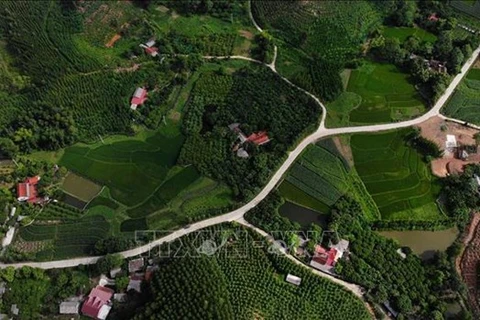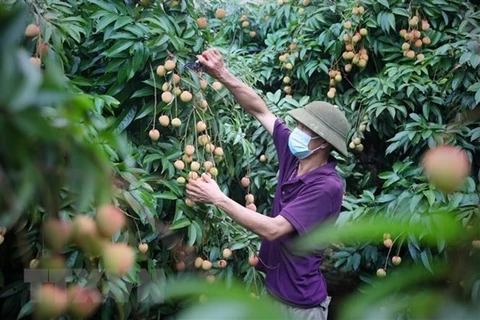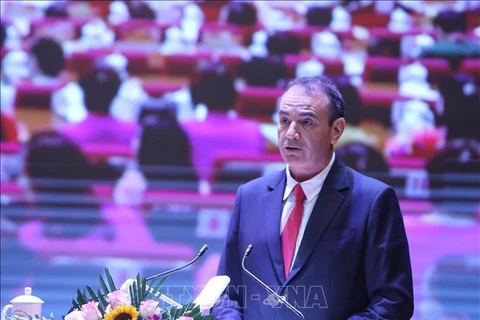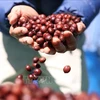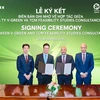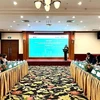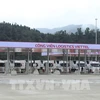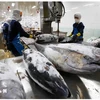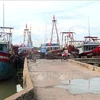 Growing vegetable in membrane houses at Organic Production, Trade and Service Cooperative in Bac Giang. (Photo: VNA)
Growing vegetable in membrane houses at Organic Production, Trade and Service Cooperative in Bac Giang. (Photo: VNA) Bac Giang, (VNA) – Bac Giang will focus attention on developing and increasing the production value of the agricultural sector in the time ahead, said Vice Chairman of the northern province’s People’s Committee Le O Pich.
Accordingly, the province will promote the development of modern agriculture and large-scale commodity production while enhancing quality, efficiency and sustainability of agricultural production.
The application of scientific-technological advances and digital transformation will be encouraged in order to raise productivity and product quality, as well as improve the value and competitiveness of local farm produce in both the domestic and export markets.
Bac Giang will prioritise the development of key products and local specialties, looking to enter the group of top producers in the country in terms of its key products.
From now to 2025, the province will strive towards an annual growth of 3 percent in added value of agro-fishery-forestry products. The average production value per one hectare of agricultural land is projected at 140 million VND (over 6,000 USD at current exchange rate) a year. The value of agro-fishery-forestry products produced by cooperatives and other forms of production linkages should account for 20 percent of the province’s total value of those products.
The value of products made using high-technology should also account for 20 percent of the total.
Bac Giang will focus efforts on developing seven key agricultural products, which are fruit trees, rice, subsidiary crops, timber trees, pigs, chicken and fish. The province will designate production areas and expand production scale with a view to building brand names and expanding markets for the products.
Each district in the province should strive to develop two to three local products depending on their local advantages, such as tea, medicinal herbs, goat, rice noodle, and other specialties.
To realize those goals, the provincial administration will work to fine-tune mechanisms and policies supporting agriculture in the direction of avoiding stretching resources, shifting from direct support to multi-form assistance combining direct and indirect support such as loan interest rate subsidy, with priority given to producers of key products and key production areas.
More attention will be paid to training agricultural labourers in applying scientific-technological advances and business administration, and promoting digital transformation in the agricultural sector.
At the same time, investment will be focused on key products, aiming to increase the combined value of the seven key products by an average 5 percent a year.
The province will develop QR codes to facilitate the sales of farm produce via online commercial platforms, promote the use of high technology throughout the process of production, harvest, processing, post-harvest preservation and product sales.
Bac Giang plans to reform the organisation of agricultural production, invest in agricultural infrastructure, and intensify trade promotion activities in both domestic and foreign markets.
Farmers will be given help to establish linkages with processing enterprises and retail chains, aiming to introduce local OCOP (One Commune One Product) and specialty products to supermarket chains, retail chains and highway service areas.
The province will strive to boost the export of key products through official channels to China, the European Union, the US, Australia and Japan.
According to Director of the provincial Department of Agriculture and Rural Development Duong Thanh Tung, Bac Giang has always been among the top agricultural producers in the country, with many products popular among both domestic and foreign consumers, such as Luc Ngan litchi, processed vegetable, Chu rice noodle, Van Village rice wine, and Yen The range chicken.
The local agro-forestry-fishery sector has been growing at an average 2.8 percent a year since 2016, reaching 21.668 trillion VND in 2021. The average production value of a hectare of agricultural land in the province was 135 million VND in 2021.
A number of concentrated commodity production zones ranging from tens to tens of thousands of hectares have been formed, mostly growing key crops such as high-quality rice, vegetable, litchi, orange and pomelo. The province has also built 304 hi-tech farming models, mainly vegetable and flower, with a total area of over 540,000 sq.m./.
